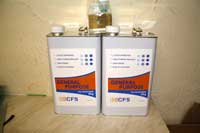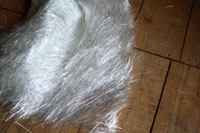Polyester Resin & Reinforcement
Polyester resin and reinforcement
This page is about Polyester resin and reinforcement, check out the main project index for the rest.
Polyester resin is typically used for traditional fiberglassing with glass fibre mat or fabric for reinforcement. It can be quite brittle in thin sections without reinforcement, but rigid and light weight if the right combination of resin and glass fibre is used.
As I mentioned in the article about Polyurethane – it can sometimes warp in large thin sections because it is quite flexible. In contrast to this Polyester resin does not easily warp as it is much more rigid, but it is brittle by itself.
For this reason, unless you’re making a solid cast in Polyester resin, you should reinforce the cast with glass fibre mat or fabric – this process is what is known as fiberglass or glass reinforced plastic (GRP). Fibre reinforced plastic (FRP) is essentially the same thing, although a variety of different fibre materials can be used for reinforcement.
The combination of resin and glass fibres make a very light weight rigid composite. This is typically what boats and kit/concept car bodies are made from, as well as my Iron Man thigh sections – because I found that Polyurethane was too bendy for this pieces:
Below are some pictures of some Polyester resin, some chopped stranded mat, and some woven roving. This is Lloyds approved/marine grade polyester resin which means it has a manufacturer guarantee and reliable cure time, but you can also buy economy grade which has neither. Polyester resin is supplied as a base product and a catalyst, the catalyst is typically added at between 1-3% depending on how fast you want it to cure. Polyester resin is considered toxic in liquid form, so you should always read the Material Safety Data Sheet (MSDS) for the product prior to use, and wear a respirator and protective clothing. You can wash out brushes and clean up any Polyester resin spills with Acetone.
Typically Polyester resin and glass fibre reinforcement are laid up/laminated by hand to inside a mould, or on the outside of an object to coat it. When fiberglassing the inside of a mould, typically two or more coats of top coat are applied to the mould, and then backed up with resin and mat. The top coat can be a specific coloured Polyester resin coat – you can buy specific ‘gel coats’ for different purposes, or you can just use standard Polyester resin brushed into the mould. Here are a couple of YouTube videos featuring me fiberglassing into Silicone moulds. Also check out my boat project where I am coating expanded polystyrene with fiberglass.
In both of these videos I am using Chopped stranded mat, which is made of short chopped glass fibres bonded in random directions. This means that they tend to fall out and get stuck to everything, however this type of mat will soak up a lot of resin and make a very rigid composite. Also pictured above is woven roving where the glass fibre strands are much longer, running from one side of the fabric to the other. This makes much neater casts, although it leaves some flexibility in the finished piece. You can also purchase combination mat which has chopped strands on one side, and woven roving on the other. Combination mat is often used in boat building.













